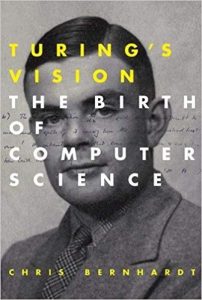Turing’s Vision, The Birth of Computer Science
Turing’s Vision, The Birth of Computer Science, by Chris Bernhardt, was published by the Massachusetts Institute of Technology in 2016, with the first MIT Press paperback edition published in 2017. Chris Bernhardt is a Professor of Mathematics at Fairfield University, a Catholic University in Fairfield, Connecticut.
Alan Mathison Turing (1912-1954), was an English mathematician, computer scientist, logician, cryptanalyst, philosopher, and theoretical biologist. He emerged into public awareness largely as a result of the 2014 American film, The Imitation Game. The film is based on the biography by Andrew Hodges, Alan Turing: The Enigma, although it is highly dramatized.
Chris Bernhardt’s book is about Turing’s great contribution to theoretical computer science in a paper that Turing wrote in 1936, when he was twenty-four years old. His talents had been recognized and he was then a Fellow at King’s College, Cambridge. The paper is titled On Computable Numbers, with an Application to the Entscheidungsproblem (decision problem). “But don’t be discouraged by the title,” writes Bernhardt, “because it contains a wealth of elegant and powerful results. It also contains some remarkably beautiful truths… This book is for the reader who wants to understand these ideas. We start from the beginning and build carefully. The reader doesn’t have to know much mathematics – high school provides enough – but it does require some mathematical aptitude and also a little work … Turing is not saying trivial things about computation, but saying deep and nonintuitive things. That said, many people find these ideas quite fascinating and the work rewarding.”
The book has a Contents section; a helpful Introduction including paragraphs of information about each of its nine Chapters; a section for Further Reading; Notes for each of the Chapters (e.g., how Boolean algebra works); a Bibliography, and an Index. The Contents section lists all of the topics in each chapter. For example, Chapter 1, Background, includes Mathematical Certainty, Boole’s Logic, Mathematical Logic, Securing the Foundations of Mathematics; Hilbert’s Approach (David Hilbert, German mathematician, 1862-1943); Gödel’s Results (Kurt Gödel, Austrian mathematician, 1906-1978); and Turing’s Results.
From Chapter 1: “Gödel had completely destroyed Hilbert’s program as it stood in 1920. Nevertheless, there was still the Entscheidungsproblem.” More »
